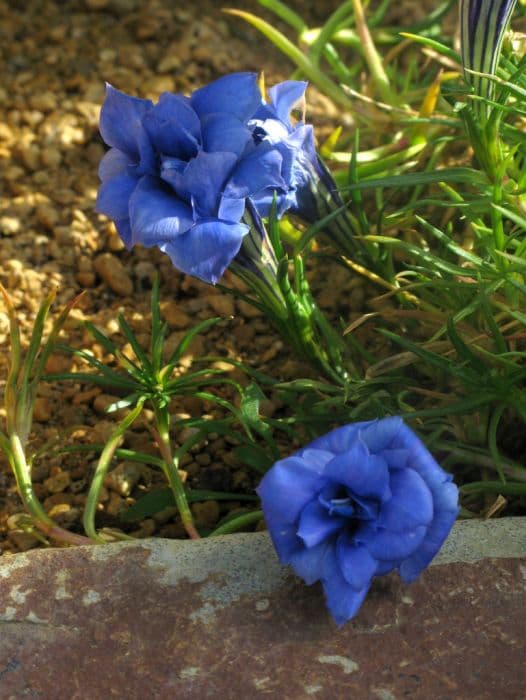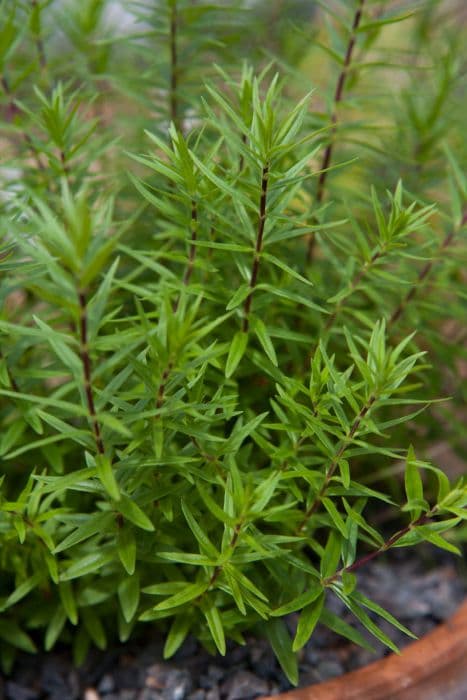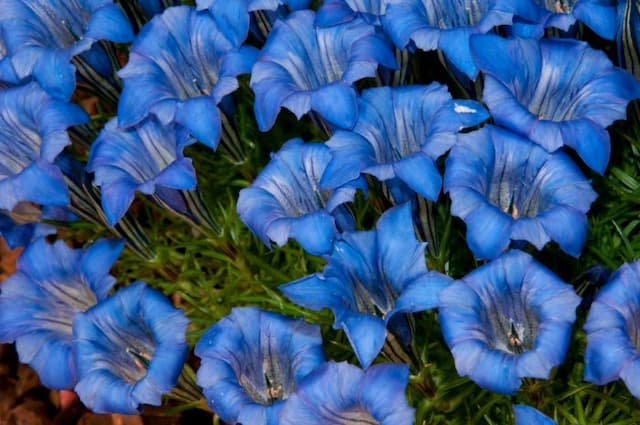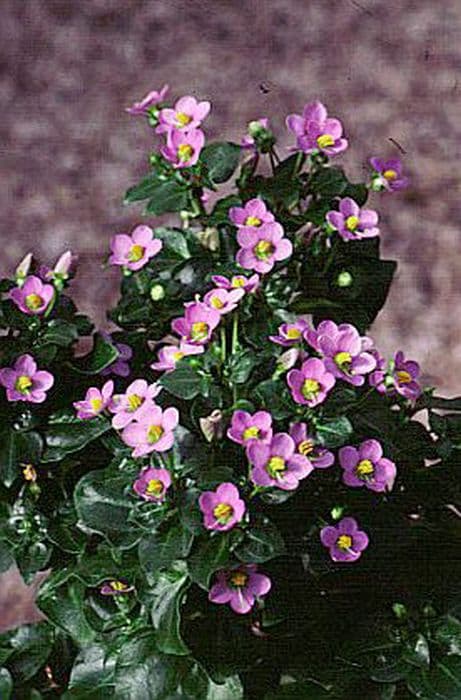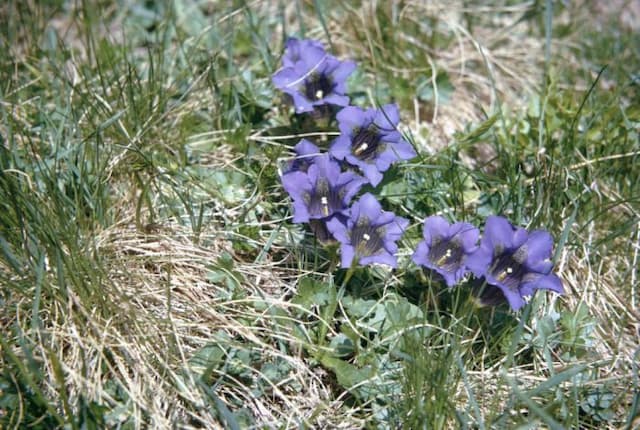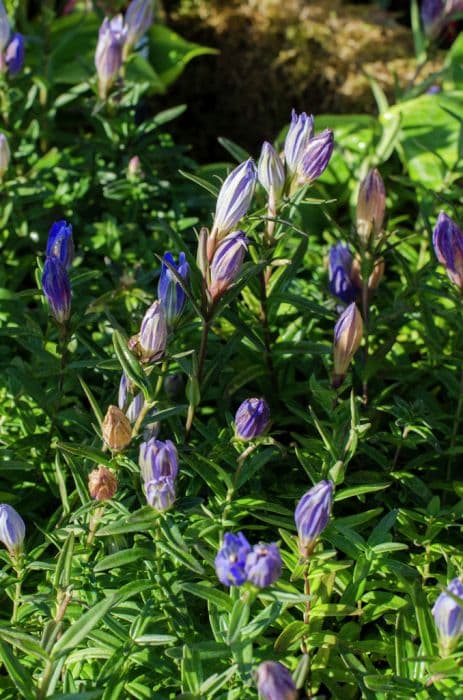Showy Chinese Gentian Gentiana sino-ornata 'Weisser Traum'

ABOUT
Gentiana sino-ornata 'Weisser Traum', commonly known as Chinese gentian 'Weisser Traum', is a striking herbaceous perennial renowned for its beautiful floral display. This plant boasts a lush foliage of lance-shaped, dark green leaves that create a dense and textured ground cover. The star attraction of the Chinese gentian 'Weisser Traum' is unquestionably its flowers. These blooms are a pure, snowy white and trumpet-shaped, with a delicate petal arrangement that gives them a frilly, flared appearance. The flowers usually have a striped or spotted pattern on the inside, which adds to their ornamental value. These eye-catching blossoms cluster at the ends of the plant's upright stems, standing out against the greenery with their pristine white color. The blooming period of the Chinese gentian 'Weisser Traum' typically occurs in late summer to early fall, during which time the plant becomes a focal point in any garden setting. The combination of the vivid green foliage and the contrasting white blooms creates a refreshing and tranquil aesthetic.
About this plant
 Names
NamesSynonyms
Showy Chinese Gentian, Ornamental Gentian, White Dream Gentian
Common names
Gentiana sino-ornata 'Weisser Traum'.
 Toxicity
ToxicityTo humans
The Chinese Gentian is not commonly known to be toxic to humans. There are no well-documented cases or reports of poisoning from ingesting this plant. However, as with any plant, individual allergies or sensitivities could cause adverse reactions.
To pets
The Chinese Gentian is not generally listed as a toxic plant to pets such as dogs and cats. There is no significant evidence to suggest that it would cause poisoning if ingested by pets. Always exercise caution and consult with a veterinarian if your pet has consumed any plant material and is showing signs of distress or illness.
 Characteristics
CharacteristicsLife cycle
Perennials
Foliage type
Evergreen
Color of leaves
Green
Flower color
White
Height
1 foot (30 cm)
Spread
1 foot (30 cm)
Plant type
Herb
Hardiness zones
6
Native area
China
Benefits
 General Benefits
General Benefits- Ornamental Appeal: Gentian 'Weisser Traum' has striking blue flowers that add a splash of vibrant color to gardens and landscapes.
- Low Maintenance: This plant is relatively easy to care for, requiring minimal upkeep once established in suitable conditions.
- Attracts Pollinators: The flowers attract bees and butterflies, promoting pollination in the garden.
- Cold Tolerant: It is well-adapted to cooler climates and can survive in lower temperatures, making it suitable for mountainous or northern regions.
- Alpine Adaptation: As an alpine plant, it thrives in rocky or gravelly soil, making it ideal for rock gardens and similar settings.
- Long Blooming Period: The plant has a long flowering period from late summer through fall, adding lasting beauty to the garden.
- Compact Size: With its small stature, it is ideal for borders, alpine gardens, or as a ground cover in small garden spaces.
- Disease Resistance: Gentian 'Weisser Traum' is generally resistant to many common garden pests and diseases.
 Medical Properties
Medical PropertiesThis plant is not used for medical purposes.
 Air-purifying Qualities
Air-purifying QualitiesThis plant is not specifically known for air purifying qualities.
 Other Uses
Other Uses- Gentiana sino-ornata, commonly known as Chinese Gentian, can be used as a natural dye for fabrics, providing a range of blue and green hues depending on the mordants used.
- The bitter taste of Chinese Gentian can be infused into liqueurs and cocktails for a unique flavor profile, particularly in artisan or craft drink concoctions.
- Dried Chinese Gentian flowers can be incorporated into potpourris or scented sachets to add a subtle fragrance and enhance freshness in closets or drawers.
- Pressed Chinese Gentian flowers can be used in botanical artworks or herbarium collections as an example of alpine flora.
- Chinese Gentian can serve as an educational tool in botanic gardens or horticultural workshops, highlighting plant adaptations in alpine environments.
- The flowers can be used in the craft of flower arranging, adding distinctive blue shades and textures to floral designs.
- Chinese Gentian can act as an indicator plant for soil pH, as it thrives in more acidic soils, helping gardeners assess their soil conditions.
- In photography, the vibrant blue flowers of Chinese Gentian offer a striking subject for macro and nature photography, particularly due to the contrast against green foliage.
- Chinese Gentian petals can be used to create natural confetti, which is biodegradable and an eco-friendly alternative to synthetic confetti at celebrations.
- Garden educators might use Chinese Gentian to teach principles of alpine garden design, utilizing its specific growth requirements as an example.
Interesting Facts
 Feng Shui
Feng ShuiThe Gentian is not used in Feng Shui practice.
 Zodiac Sign Compitability
Zodiac Sign CompitabilityThe Gentian is not used in astrology practice.
 Plant Symbolism
Plant Symbolism- Persistence and Resilience: Gentiana sino-ornata, commonly known as Chinese Gentian, often symbolizes persistence and resilience due to its ability to thrive in harsh mountainous environments.
- Victory and Triumph: In the language of flowers, Chinese Gentian can represent victory or triumph, as it can overcome difficult conditions to bloom brightly.
- Inner Strength: Reflecting on the plant's sturdy nature, it is frequently associated with inner strength and the fortitude to face life's challenges.
- Integrity and Nobility: Historically, the Gentian family of flowers has been connected to integrity and nobility, possibly stemming from its impressive and dignified appearance.
- Longevity: With its vigorous growth habits and long-lasting blooms, the Chinese Gentian also symbolizes a wish for longevity and good health.
 Water
WaterFor the Chinese Gentian, watering should be done carefully to ensure the soil is moist but not waterlogged. During active growth in the spring and summer, water the plant thoroughly once the top inch of the soil feels dry, typically every week or so, with about 1 gallon of water each time. In the cooler fall and winter months, reduce watering to every other week, providing 1/2 gallon, as the plant's water needs decrease. It's crucial to provide consistent moisture but also to avoid overwatering to prevent root rot.
 Light
LightThe Chinese Gentian thrives best in partial shade where it receives bright, indirect light. It should be placed in a spot where it can be shielded from the harsh afternoon sun, as too much direct sunlight can damage the foliage. A location that gets morning sun followed by dappled shade or filtered light during the more intense afternoon hours is ideal.
 Temperature
TemperatureThe Chinese Gentian prefers a cool environment and will thrive in temperatures that range from 50°F to 70°F. It can survive minimum temperatures down to about 40°F but should be protected from frost. During the hot summer months, ensure that the plant is not exposed to temperatures exceeding 75°F for prolonged periods to avoid heat stress.
 Pruning
PruningPruning the Chinese Gentian is mostly to remove spent flowers and damaged leaves, which encourages new growth and maintains the plant's appearance. The best time to prune is after flowering has finished in late fall; cut back the stems to just above a leaf node. Pruning should be done annually or as needed when there is visible dead or damaged foliage.
 Cleaning
CleaningAs needed
 Soil
SoilThe best soil mix for Chinese Gentian 'Weisser Traum' is one that is well-draining with a mixture of loam, peat, and sharp sand. The pH should be slightly acidic to neutral, ranging from 5.5 to 7.2 for optimal growth.
 Repotting
RepottingChinese Gentian 'Weisser Traum' should be repotted every two to three years to refresh the soil and accommodate the root growth. Springtime is ideal for repotting to minimize stress on the plant.
 Humidity & Misting
Humidity & MistingChinese Gentian 'Weisser Traum' thrives in moderate humidity conditions. Aim for a humidity level between 50-60% for this plant to flourish.
 Suitable locations
Suitable locationsIndoor
Place in bright, indirect light with cool temps.
Outdoor
Partial shade, cool area, protect from hot sun.
Hardiness zone
4-8 USDA
 Life cycle
Life cycleThe life cycle of Gentiana sino-ornata 'Weisser Traum', commonly referred to as 'Weisser Traum' Gentian, begins with seed germination, typically occurring in cold conditions or after a period of stratification to simulate winter. Upon germination, the seedling emerges and, given proper conditions of cool temperatures and adequate moisture, develops into a clump of basal leaves. As the plant matures, it develops a robust root system and foliage, preparing for the flowering stage. Flowering typically occurs from late summer to autumn, with 'Weisser Traum' producing bell-shaped, white flowers that attract pollinators. After pollination, the flowers will develop into small, dry fruit capsules containing numerous seeds. The plant may enter a period of dormancy during the cold winter months, resuming growth and the cycle anew with the return of favorable spring conditions.
 Propogation
PropogationPropogation time
Late Summer to Fall
Gentiana sino-ornata 'Weisser Traum', commonly referred to as the Gentian 'Weisser Traum', is often propagated by seed. The most popular method to propagate this plant is to sow the seeds as soon as they are ripe in a cold frame. Ideally, sowing should be done in the late winter to early spring. The seeds require stratification, a process of cold treatment, for two to four weeks at temperatures between 32 to 41 degrees Fahrenheit (0 to 5 degrees Celsius) to break dormancy. After stratification, the seeds should be lightly covered with soil and kept moist. They require light to germinate, so it’s important not to bury them too deeply. Seedlings can be transplanted into individual pots once they are large enough to handle and can be moved outdoors after the last frost has passed.

